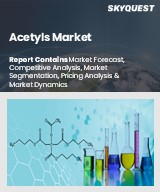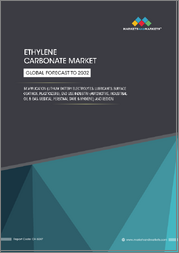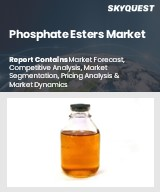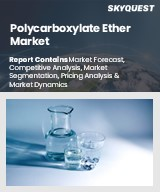
|
시장보고서
상품코드
1809864
친환경 가소제 시장 : 제품별, 원재료별, 제형별, 기능별, 최종사용자별, 판매채널별 - 세계 예측(2025-2030년)Eco-Friendly Plasticizers Market by Product, Raw Material Source, Formulation, Functionality, End-User, Sales Channel - Global Forecast 2025-2030 |
||||||
친환경 가소제 시장은 2024년 38억 4,000만 달러로 평가되었습니다. 2025년에는 41억 1,000만 달러에 이르고, CAGR 7.30%로 성장하여 2030년에는 58억 7,000만 달러에 달할 것으로 예측됩니다.
| 주요 시장 통계 | |
|---|---|
| 기준 연도 : 2024년 | 38억 4,000만 달러 |
| 추정 연도 : 2025년 | 41억 1,000만 달러 |
| 예측 연도 : 2030년 | 58억 7,000만 달러 |
| CAGR(%) | 7.30% |
지속 가능한 가소제의 진화를 소개합니다. 친환경 첨단 화학 및 시장 연계로 소재의 변화를 이끌어냅니다.
친환경 가소제의 발전은 재료 과학과 산업 화학의 중요한 전환점이며, 기존의 프탈레이트 화합물을 대체할 수 있는 지속 가능한 대안을 제공합니다. 전 세계 이해관계자들이 환경 보호와 인체 건강을 점점 더 우선순위에 두면서 재생 가능한 원료에서 추출한 가소제에 대한 수요가 급증하고 있습니다. 이러한 혁신적인 첨가제는 엄격한 규제 요건을 충족할 뿐만 아니라 유연성 향상, 열 안정성 강화, 내구성 향상 등 기존 대안과 동등하거나 그 이상의 성능 특성을 발휘합니다.
기술 혁신과 규제 모멘텀별 친환경 가소제 정세를 형성하는 중요한 변화를 살펴봅니다.
최근 친환경 가소제 분야는 원료 혁신, 규제 강화, 용도에 따른 성능 향상이라는 획기적인 변화를 목격했습니다. 농업 잔류물 및 비식용 작물에서 추출한 차세대 바이오 원료의 등장은 원료 기반을 크게 확대하여 보다 비용 경쟁력 있는 배합의 길을 열었습니다. 동시에 효소 촉매 작용의 발전은 생산 공정을 간소화하여 에너지 소비와 폐기물 발생을 줄이고 전반적인 수율과 순도를 향상시켰습니다.
2025년 미국 관세 개정이 공급망에 미치는 복잡한 영향 분석 가격 구조와 시장 접근성
2025년에 시행된 미국의 관세 개정은 친환경 가소제와 그 전구체 물질의 국경 간 무역 흐름에 새로운 복잡성을 가져왔습니다. 특정 구연산 기반 중간체 및 특수 글리세릴 사료에 대한 관세율 인상은 수입 비용 상승 압력을 가하여 배합업체들이 조달 전략과 재고 계획을 재검토하도록 유도하고 있습니다. 이에 따라 일부 일류 제조업체들은 국내 공급업체와의 장기 계약을 재협상하여 리스크를 줄이는 한편, 공급의 연속성을 보장하기 위해 현지 생산 능력에 투자하고 있습니다.
중요한 시장 세분화 통찰력, 제품 원료의 배합 기능 최종 사용자 및 채널 역학에 대한 통찰력을 통해 밝혀졌습니다.
중요한 시장 세분화를 고려하면, 제품의 다양성이 기본 렌즈로 떠오릅니다. 배합자는 유연성, 적합성, 저휘발성 등 특정 성능 속성을 달성하기 위해 구연산 가소제, 글리세릴 에스테르 가소제, 숙신산 가소제 등을 구분합니다. 동시에 원료 공급원 구분에서는 고순도 및 일관된 특성을 제공하는 동물성 원료와 재생 가능성과 탄소 발자국 감소를 우선시하는 식물성 원료의 대비가 강조됩니다. 또한, 배합에 따른 계층화에서는 열가소성 수지 블렌드에 쉽게 통합할 수 있는 액체 시스템과 특수한 용도에서 방출 제어가 가능한 파우더 포맷으로 시장을 구분하고 있습니다.
미주, 유럽, 중동/아프리카, 아시아태평양 시장의 지역 역학 및 성장 궤적 파악, 타겟팅 전략 수립
지역 역학은 친환경 가소제 시장을 독특한 방식으로 형성하고 있습니다. 북미에서는 강력한 규제 프레임워크와 강력한 R&D 생태계가 결합되어 특히 북미 자동차 및 포장 분야에서 바이오 가소제의 급속한 채택을 촉진하고 있습니다. 지속 가능한 제조 시설에 대한 투자와 그린 케미컬 혁신에 대한 인센티브는 국내 생산 능력을 더욱 가속화하여 현지 기업이 국제 공급업체와 효과적으로 경쟁할 수 있도록 돕고 있습니다.
친환경 가소제 개발의 진보를 주도하는 업계 선두 업체들의 혁신적 협업과 경쟁 전략이 돋보입니다.
주요 화학 기업들은 목표 혁신, 전략적 파트너십, 인수합병을 통해 친환경 가소제 시장을 주도하고 있습니다. BASF, Dow 등 세계 기업들은 고온 용도에 효과적인 차세대 숙신산 유도체와 글리세릴 에스테르 계열로 제품 포트폴리오를 확장하고 있습니다. 에보닉은 바이오 생산 플랫폼에 대한 투자를 확대하고, 원료 공급업체와 협력하여 지속 가능한 투입을 보장하고 전환 효율을 최적화하고 있습니다.
지속 가능한 가소제의 채택을 촉진하기 위한 경쟁적 고려사항 및 전략적 제안운영적 우수성과 시장 경쟁력
친환경 가소제 분야에서 새로운 기회를 활용하기 위해 업계 리더들은 원료의 다양화와 친환경 가공 기술에 대한 전략적 투자를 우선시해야 합니다. 농업협동조합 및 바이오리파이너리 사업자와의 파트너십을 통해 제조업체는 가격 변동을 완화하면서 확장 가능하고 저탄소적인 원료를 확보할 수 있습니다. 또한, 디지털 프로세스 제어와 고급 분석을 통합하여 운영의 탄력성을 강화하고, 공급망 혼란과 규제 변화에 민첩하게 대응할 수 있도록 지원합니다.
강력한 시장 인텔리전스를 위한 데이터 수집 분석 프로토콜과 검증 기술을 통합한 엄격한 조사 방법론에 대해 자세히 알아보세요.
이 조사 방법은 1차 정보와 2차 정보를 결합한 강력한 데이터 소스를 활용하여 종합적인 시장 인텔리전스를 확보합니다. 화학 제조업체, 원료 공급업체, 최종 용도 변환기, 규제 전문가 등 주요 이해관계자들과의 심층 인터뷰를 통해 1차적인 통찰력을 얻었습니다. 이 인터뷰는 기술 동향, 공급망 역학, 조달 전략에 대한 질적 관점을 파악하기 위해 구성되었습니다.
친환경 가소제의 미래에 대한 결론적 관점 지속 가능한 성장을 위한 협력과 혁신의 중요성
규제의 필요성, 기술의 비약적인 발전, 소비자의 선호도 변화의 융합은 친환경 가소제의 보급을 위한 설득력 있는 무대를 마련했습니다. 산업이 계속 진화함에 따라, 원료의 제약을 극복하고, 인증 프로세스를 간소화하고, 새로운 화학 물질을 확장하기 위해서는 전체 밸류체인의 협력이 필수적입니다. 지속가능성 기준은 점점 더 조달 의사결정에 영향을 미치게 될 것이며, 투명한 공급망과 검증 가능한 라이프사이클 혜택에 대한 요구가 높아질 것으로 보입니다.
목차
제1장 서문
제2장 조사 방법
제3장 주요 요약
제4장 시장 개요
제5장 시장 역학
제6장 시장 인사이트
- Porter's Five Forces 분석
- PESTEL 분석
제7장 미국 관세의 누적 영향 2025
제8장 친환경 가소제 시장 : 제품별
- 구연산 에스테르 가소제
- 글리세릴 에스터 가소제
- 숙신산계 가소제
제9장 친환경 가소제 시장 : 원재료별
- 동물 유래
- 식물 유래
제10장 친환경 가소제 시장 : 제형별
- 액체
- 분말
제11장 친환경 가소제 시장 : 기능성별
- 접착성 향상제
- 결합 향상
- 내열성
- 안정성 향상제
제12장 친환경 가소제 시장 : 최종사용자별
- 농업 및 원예
- 농업 필름
- 온실 커버
- 자동차
- 외장 부품
- 내장 부품
- 건축 및 건설
- 바닥재 및 벽지
- 파이프 및 피팅
- 소비재
- 의료기기
- 포장
- 소비재 포장
- 식품 포장
- 섬유 및 의류
제13장 친환경 가소제 시장 : 판매채널별
- 오프라인
- 직접 판매
- 유통업체 및 도매업체
- 온라인
- 기업 소유 포털
- E-Marketplaces
제14장 아메리카의 친환경 가소제 시장
- 미국
- 캐나다
- 멕시코
- 브라질
- 아르헨티나
제15장 유럽, 중동 및 아프리카의 친환경 가소제 시장
- 영국
- 독일
- 프랑스
- 러시아
- 이탈리아
- 스페인
- 아랍에미리트(UAE)
- 사우디아라비아
- 남아프리카공화국
- 덴마크
- 네덜란드
- 카타르
- 핀란드
- 스웨덴
- 나이지리아
- 이집트
- 튀르키예
- 이스라엘
- 노르웨이
- 폴란드
- 스위스
제16장 아시아태평양의 친환경 가소제 시장
- 중국
- 인도
- 일본
- 호주
- 한국
- 인도네시아
- 태국
- 필리핀
- 말레이시아
- 싱가포르
- 베트남
- 대만
제17장 경쟁 구도
- 시장 점유율 분석, 2024
- FPNV 포지셔닝 매트릭스, 2024
- 경쟁 분석
- BASF SE
- Eastman Chemical Company
- ACS Technical Products
- ADEKA Corporation
- American Polyfilm, Inc.
- Arkema Group
- Avient Corporation
- BioAmber Inc.
- Dow Inc.
- Emery Oleochemicals
- Evonik Industries AG
- ExxonMobil Chemical Company
- Galata Chemicals
- Grupa Azoty
- Hanwha Group
- Jungbunzlauer Suisse AG
- Lanxess AG
- LG Chem Ltd
- OQ Chemicals
- Perstorp Group
- Proviron Inc.
- Shandong Novista Chemicals Co.,Ltd(Novista Group)
- Tecnosintesi SpA
- UPC Technology Corporation
- Vertellus Holdings LLC
제18장 리서치 AI
제19장 리서치 통계
제20장 리서치 컨택트
제21장 리서치 기사
제22장 부록
LSH 25.09.22The Eco-Friendly Plasticizers Market was valued at USD 3.84 billion in 2024 and is projected to grow to USD 4.11 billion in 2025, with a CAGR of 7.30%, reaching USD 5.87 billion by 2030.
| KEY MARKET STATISTICS | |
|---|---|
| Base Year [2024] | USD 3.84 billion |
| Estimated Year [2025] | USD 4.11 billion |
| Forecast Year [2030] | USD 5.87 billion |
| CAGR (%) | 7.30% |
Introducing the Evolution of Sustainable Plasticizers Transforming Materials through Advanced Eco-Conscious Chemistry and Market Alignment
The advancement of eco-friendly plasticizers marks a critical turning point in materials science and industrial chemistry, offering sustainable alternatives to traditional phthalate-based compounds. As global stakeholders increasingly prioritize environmental stewardship and human health, the demand for plasticizers derived from renewable feedstocks has risen sharply. These innovative additives not only meet stringent regulatory requirements but also deliver performance characteristics-such as improved flexibility, enhanced thermal stability and increased durability-that parallel or exceed conventional options.
Driven by consumer awareness of chemical safety and bolstered by government initiatives targeting the reduction of hazardous substances, manufacturers are seeking solutions that align with circular economy principles. The introduction of biobased raw materials, including citric acid esters, glyceryl esters and succinic acid derivatives, underscores the industry's shift toward cleaner production pathways. Moreover, the integration of green chemistry principles and closed-loop processing techniques is reshaping how plasticizers are conceptualized, formulated and brought to market.
This executive summary synthesizes the most salient trends, regulatory influences and strategic insights within the eco-friendly plasticizer domain, setting the stage for informed decision-making. Stakeholders will gain a clear understanding of the transformative forces at play, enabling them to navigate competitive dynamics, optimize product portfolios and harness emerging opportunities in a rapidly evolving landscape.
Exploring Pivotal Shifts Reshaping the Eco-Friendly Plasticizer Landscape through Technological Innovations and Regulatory Momentum
Recent years have witnessed transformative shifts in the eco-friendly plasticizer sector characterized by breakthroughs in feedstock innovation, regulatory reinforcement and application-driven performance enhancements. The advent of next-generation biofeedstocks extracted from agricultural residues and nonfood crops has significantly expanded the raw material base, paving the way for more cost-competitive formulations. Concurrently, advances in enzymatic catalysis have streamlined production processes, reducing energy consumption and waste generation while boosting overall yield and purity.
Heightened regulatory momentum across North America, Europe and Asia has further accelerated the market transition away from phthalates and other legacy plasticizers. Stricter emission standards and mandatory disclosure requirements have compelled formulators to adopt transparent supply chains and verify the sustainability credentials of their inputs. This confluence of legislative pressure and consumer advocacy has fueled a wave of collaborative partnerships, as chemical manufacturers, academic institutions and industry consortia work in tandem to validate new chemistries and scale pilot projects.
Moreover, end-use sectors-ranging from automotive interiors to flexible medical devices-are demanding tailored performance solutions that deliver high adhesion, thermal resilience and long-term stability. As a result, innovation has become a competitive imperative, driving continuous refinement of molecular architectures and co-additive systems. Through these combined forces, the eco-friendly plasticizer landscape is undergoing a fundamental metamorphosis, setting the stage for sustained growth and differentiation.
Analyzing the Complex Impact of United States Tariff Adjustments in 2025 on Supply Chains Pricing Structures and Market Accessibility
The United States' tariff revisions enacted in 2025 have introduced new complexities to cross-border trade flows of eco-friendly plasticizers and their precursors. Elevations in duty rates on selected citric acid-based intermediates and specialized glyceryl feeds have exerted upward pressure on import costs, prompting formulators to revisit sourcing strategies and inventory planning. In response, some tier-one producers have renegotiated long-term contracts with domestic suppliers to mitigate exposure, while others are investing in localized manufacturing capabilities to ensure supply continuity.
Beyond cost implications, the tariff landscape has catalyzed a recalibration of global value chains. Companies with robust logistic networks are leveraging tariff engineering techniques, such as tariff-rate quotas and preferential trade agreements, to optimize landed costs and sustain competitive pricing. Meanwhile, smaller entities lacking scale advantages have faced heightened margin compression, driving consolidation and select vertical integration moves within the supply base.
Despite these headwinds, the broader momentum toward nonphthalate and biobased plasticizers remains intact. Industry stakeholders are deploying scenario planning and agile procurement frameworks to navigate the evolving duties, while policymakers continue to align trade policy with broader environmental objectives. As a result, the 2025 tariff adjustments have become both a catalyst for operational resilience and a strategic inflection point for manufacturers committed to eco-conscious product development.
Unveiling Critical Market Segmentation Insights Revealing Product Raw Material Formulation Functionality End-User and Channel Dynamics
In examining critical market segmentation, product diversity emerges as a foundational lens, with formulators distinguishing between citric acid ester plasticizer, glyceryl ester plasticizer and succinic acid-based plasticizer to achieve specific performance attributes such as flexibility, compatibility and low volatility. Simultaneously, raw material source segmentation highlights the contrast between animal-based feedstocks, which offer high purity and consistent properties, and plant-based sources, which prioritize renewability and reduced carbon footprint. Formulation-based stratification further delineates the market into liquid systems that facilitate easy incorporation into thermoplastic blends and powder formats that enable controlled release in specialized applications.
Functionality-driven segmentation underscores the dual imperatives of adhesion improvers and stability enhancers, with adhesion improvers further categorized by their efficacy in improving bonding and their robustness under extreme temperature resistance conditions. End-user analysis reveals a broad spectrum of verticals: agriculture and horticulture applications incorporate agricultural films and greenhouse covers; automotive uses span exterior components and interior trim; building and construction projects rely on flooring and wall coverings as well as pipes and fittings; consumer goods embrace flexible packaging solutions; medical devices require biocompatible plasticizer systems; and textile and apparel sectors benefit from enhanced fabric elasticity. Packaging applications, in particular, bifurcate into consumer goods packaging and food packaging, each demanding tailored regulatory compliance and performance profiles. Finally, sales channel segmentation captures the traditional strength of offline direct sales and distributor or wholesaler networks alongside the burgeoning growth of online channels, including company-owned portals and third-party e-marketplaces, each offering distinct advantages in reach, cost efficiency and customer engagement.
Exposing Regional Dynamics and Growth Trajectories across the Americas Europe Middle East Africa and Asia-Pacific Markets for Targeted Strategies
Regional dynamics shape the eco-friendly plasticizer market in unique ways. In the Americas, robust regulatory frameworks combined with strong R&D ecosystems have fostered rapid adoption of biobased plasticizers, particularly in North America's automotive and packaging sectors. Investments in sustainable manufacturing facilities and incentives for green chemistry innovation have further accelerated domestic production capacity, enabling local players to compete effectively against international suppliers.
Across Europe, the Middle East and Africa, stringent chemical safety regulations and ambitious carbon reduction targets have galvanized formulators to integrate eco-friendly plasticizers into a wide array of applications. European policymakers continue to refine substance restrictions and registration requirements, compelling industry participants to maintain rigorous compliance while exploring novel feedstock streams. In parallel, growing demand in key emerging markets within the Middle East and Africa is driven by infrastructure development and the expansion of agricultural exports, creating new opportunities for flexible films and coating formulations.
The Asia-Pacific region remains a hotbed of growth, propelled by large-scale investments in consumer electronics, flexible packaging and medical device manufacturing across East and Southeast Asia. Rapid urbanization and rising disposable incomes have heightened consumer demand for high-performance, environmentally responsible products. Local chemical producers are scaling bio-based production platforms and forging strategic alliances with global technology partners, thereby enhancing their capabilities in specialty plasticizer development.
Highlighting Leading Industry Players Innovations Collaborations and Competitive Strategies Driving Advancements in Eco-Friendly Plasticizer Development
Leading chemical companies are driving the eco-friendly plasticizer market forward through targeted innovations, strategic partnerships and acquisitive growth. Global players such as BASF and Dow have expanded their product portfolios with next-generation succinic acid derivatives and glyceryl ester systems validated for high-temperature applications. Evonik has deepened its investment in bio-based production platforms, collaborating with feedstock suppliers to secure sustainable inputs and optimize conversion efficiency.
Eastman has leveraged its proprietary molecular design expertise to develop plasticizer blends that enhance material recyclability, while Arkema has focused on performance polymer integration, delivering solutions with improved compounding compatibility and reduced volatile organic compound emissions. Emerging specialists like Croda and Vertellus are carving out niches in custom-tailored formulations for niche verticals such as medical devices and horticultural films, using modular production lines and agile supply chains. Concurrently, mid-tier innovators and regional manufacturers are strengthening their competitive positions through joint ventures and licensing agreements that broaden technical capabilities and market reach.
Collectively, these companies are redefining performance benchmarks and establishing new standards for sustainability, setting the course for differentiated product offerings that address complex end-use requirements and align with evolving regulatory paradigms.
Driving Actionable Insights and Strategic Recommendations to Propel Sustainable Plasticizer Adoption Operational Excellence and Market Competitiveness
To capitalize on emerging opportunities in the eco-friendly plasticizer domain, industry leaders should prioritize strategic investments in feedstock diversification and green processing technologies. By establishing partnerships with agricultural cooperatives and biorefinery operators, manufacturers can secure scalable, low-carbon inputs while mitigating price volatility. Furthermore, integrating digital process controls and advanced analytics will enhance operational resilience, enabling agile responses to supply chain disruptions and regulatory shifts.
Stakeholders should also engage proactively with policymakers and standards bodies to shape favorable regulatory frameworks, advocating for incentives that support circular economy initiatives and drive sustainable chemistry adoption. In parallel, collaborative research efforts with universities and independent laboratories can accelerate the validation of novel plasticizer chemistries, shortening time-to-market and reducing development risk.
To strengthen market traction, companies must refine their value propositions by demonstrating clear life-cycle benefits, such as reduced environmental impact and enhanced product recyclability. Tailored marketing campaigns that highlight case studies and third-party certifications will foster trust among end users. Finally, expanding digital sales channels through dedicated e-commerce platforms and virtual technical service portals can broaden customer reach, improve engagement and reinforce the company's position as a forward-looking innovator.
Detailing Rigorous Research Methodology Integrating Data Collection Analysis Protocols and Validation Techniques for Robust Market Intelligence
This research leverages a robust methodology combining primary and secondary data sources to ensure comprehensive market intelligence. Primary insights were obtained through in-depth interviews with key stakeholders, including chemical manufacturers, raw material suppliers, end-use converters and regulatory experts. These interviews were structured to capture qualitative perspectives on technology trends, supply chain dynamics and procurement strategies.
Secondary research encompassed an extensive review of industry publications, patent filings, technical white papers and regulatory databases. Proprietary databases and trade association reports supplemented these sources, providing quantitative context and historical benchmarks. Data triangulation techniques were employed to reconcile disparate figures and validate findings, while cross-functional expert panels reviewed preliminary results to ensure consistency and accuracy.
Analytical models, including SWOT analysis, value chain mapping and scenario planning, were applied to interpret market drivers, constraints and growth catalysts. Validation workshops with industry advisors and third-party consultants further refined the insights, resulting in a research output that delivers actionable guidance and a clear understanding of the evolving eco-friendly plasticizer landscape.
Concluding Perspectives on the Future of Eco-Conscious Plasticizers Emphasizing Sustainable Growth Collaboration and Innovation Imperatives
The convergence of regulatory imperatives, technological breakthroughs and shifting consumer preferences has set a compelling stage for the proliferation of eco-friendly plasticizers. As the industry continues to evolve, collaboration across the value chain will be essential to overcome feedstock limitations, streamline certification processes and scale novel chemistries. Sustainability criteria will increasingly influence procurement decisions, driving demand for transparent supply chains and verifiable life-cycle benefits.
Innovation will remain the cornerstone of differentiation, with the most successful players balancing performance optimization with environmental objectives. Strategic alliances between chemical producers, research institutions and end users will accelerate the translation of laboratory discoveries into commercial offerings. At the same time, agile manufacturing systems and digital transformation initiatives will underpin resilience in the face of dynamic trade policies and volatile raw material markets.
Looking ahead, the eco-friendly plasticizer market is poised for sustained growth as industry leaders harness these converging trends. By embracing a holistic approach that integrates product innovation, regulatory engagement and operational excellence, companies can unlock new value streams, foster stakeholder trust and lead the transition toward a more sustainable materials ecosystem.
Table of Contents
1. Preface
- 1.1. Objectives of the Study
- 1.2. Market Segmentation & Coverage
- 1.3. Years Considered for the Study
- 1.4. Currency & Pricing
- 1.5. Language
- 1.6. Stakeholders
2. Research Methodology
- 2.1. Define: Research Objective
- 2.2. Determine: Research Design
- 2.3. Prepare: Research Instrument
- 2.4. Collect: Data Source
- 2.5. Analyze: Data Interpretation
- 2.6. Formulate: Data Verification
- 2.7. Publish: Research Report
- 2.8. Repeat: Report Update
3. Executive Summary
4. Market Overview
- 4.1. Introduction
- 4.2. Market Sizing & Forecasting
5. Market Dynamics
- 5.1. Increasing demand for non-toxic and biodegradable plasticizers in packaging applications
- 5.2. Integration of nanotechnology in developing high-efficiency eco-friendly plasticizers
- 5.3. Strategic partnerships and collaborations accelerating innovation in eco-friendly plasticizer formulations
- 5.4. Shifts in consumer preferences towards greener products influencing eco-friendly plasticizer market growth
- 5.5. Emergence of renewable raw materials as key components in eco-friendly plasticizer manufacturing
- 5.6. Growth of the automotive sector demanding lightweight and eco-friendly plasticizer solutions
- 5.7. Role of circular economy initiatives in boosting sustainable plasticizer production and consumption
- 5.8. Impact of regulatory policies on the adoption of eco-friendly plasticizers in various industries
- 5.9. Technological advancements enhancing performance and sustainability of eco-friendly plasticizers
- 5.10. Rising adoption of bio-based plasticizers driving market transformation in eco-friendly plasticizers
6. Market Insights
- 6.1. Porter's Five Forces Analysis
- 6.2. PESTLE Analysis
7. Cumulative Impact of United States Tariffs 2025
8. Eco-Friendly Plasticizers Market, by Product
- 8.1. Introduction
- 8.2. Citric Acid Ester Plasticizer
- 8.3. Glyceryl Ester Plasticizer
- 8.4. Succinic Acid-Based Plasticizer
9. Eco-Friendly Plasticizers Market, by Raw Material Source
- 9.1. Introduction
- 9.2. Animal-Based
- 9.3. Plant-Based
10. Eco-Friendly Plasticizers Market, by Formulation
- 10.1. Introduction
- 10.2. Liquid
- 10.3. Powder
11. Eco-Friendly Plasticizers Market, by Functionality
- 11.1. Introduction
- 11.2. Adhesion Improvers
- 11.2.1. Improved Bonding
- 11.2.2. Temperature Resistance
- 11.3. Stability Enhancers
12. Eco-Friendly Plasticizers Market, by End-User
- 12.1. Introduction
- 12.2. Agriculture & Horticulture
- 12.2.1. Agricultural Films
- 12.2.2. Greenhouse Covers
- 12.3. Automotive
- 12.3.1. Exterior Components
- 12.3.2. Interior Components
- 12.4. Building & Construction
- 12.4.1. Flooring & Wall Coverings
- 12.4.2. Pipes & Fittings
- 12.5. Consumer Goods
- 12.6. Medical Devices
- 12.7. Packaging
- 12.7.1. Consumer Goods Packaging
- 12.7.2. Food Packaging
- 12.8. Textile & Apparel
13. Eco-Friendly Plasticizers Market, by Sales Channel
- 13.1. Introduction
- 13.2. Offline
- 13.2.1. Direct Sales
- 13.2.2. Distributors/Wholesalers
- 13.3. Online
- 13.3.1. Company-Owned Portals
- 13.3.2. E-Marketplaces
14. Americas Eco-Friendly Plasticizers Market
- 14.1. Introduction
- 14.2. United States
- 14.3. Canada
- 14.4. Mexico
- 14.5. Brazil
- 14.6. Argentina
15. Europe, Middle East & Africa Eco-Friendly Plasticizers Market
- 15.1. Introduction
- 15.2. United Kingdom
- 15.3. Germany
- 15.4. France
- 15.5. Russia
- 15.6. Italy
- 15.7. Spain
- 15.8. United Arab Emirates
- 15.9. Saudi Arabia
- 15.10. South Africa
- 15.11. Denmark
- 15.12. Netherlands
- 15.13. Qatar
- 15.14. Finland
- 15.15. Sweden
- 15.16. Nigeria
- 15.17. Egypt
- 15.18. Turkey
- 15.19. Israel
- 15.20. Norway
- 15.21. Poland
- 15.22. Switzerland
16. Asia-Pacific Eco-Friendly Plasticizers Market
- 16.1. Introduction
- 16.2. China
- 16.3. India
- 16.4. Japan
- 16.5. Australia
- 16.6. South Korea
- 16.7. Indonesia
- 16.8. Thailand
- 16.9. Philippines
- 16.10. Malaysia
- 16.11. Singapore
- 16.12. Vietnam
- 16.13. Taiwan
17. Competitive Landscape
- 17.1. Market Share Analysis, 2024
- 17.2. FPNV Positioning Matrix, 2024
- 17.3. Competitive Analysis
- 17.3.1. BASF SE
- 17.3.2. Eastman Chemical Company
- 17.3.3. ACS Technical Products
- 17.3.4. ADEKA Corporation
- 17.3.5. American Polyfilm, Inc.
- 17.3.6. Arkema Group
- 17.3.7. Avient Corporation
- 17.3.8. BioAmber Inc.
- 17.3.9. Dow Inc.
- 17.3.10. Emery Oleochemicals
- 17.3.11. Evonik Industries AG
- 17.3.12. ExxonMobil Chemical Company
- 17.3.13. Galata Chemicals
- 17.3.14. Grupa Azoty
- 17.3.15. Hanwha Group
- 17.3.16. Jungbunzlauer Suisse AG
- 17.3.17. Lanxess AG
- 17.3.18. LG Chem Ltd
- 17.3.19. OQ Chemicals
- 17.3.20. Perstorp Group
- 17.3.21. Proviron Inc.
- 17.3.22. Shandong Novista Chemicals Co.,Ltd (Novista Group)
- 17.3.23. Tecnosintesi SpA
- 17.3.24. UPC Technology Corporation
- 17.3.25. Vertellus Holdings LLC



















